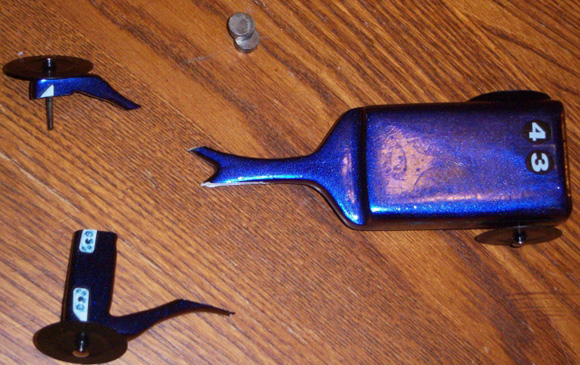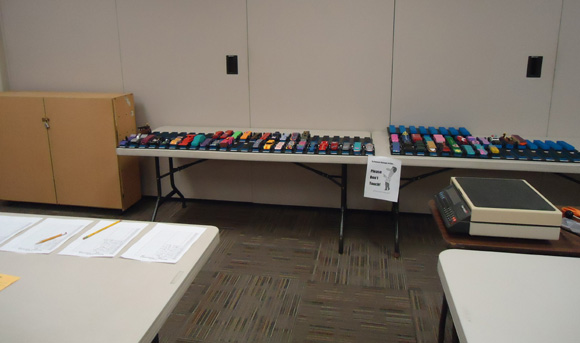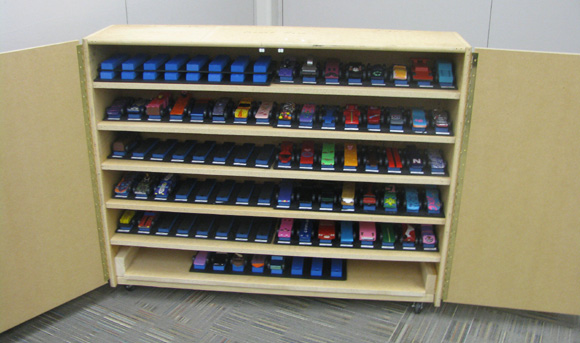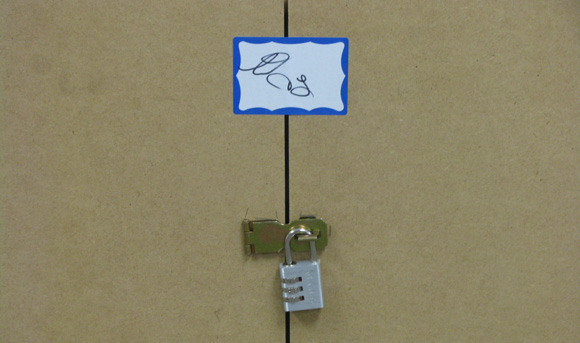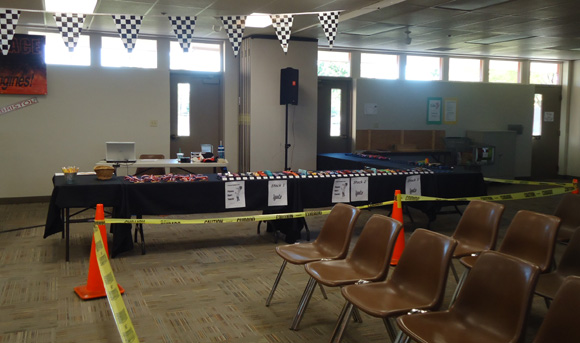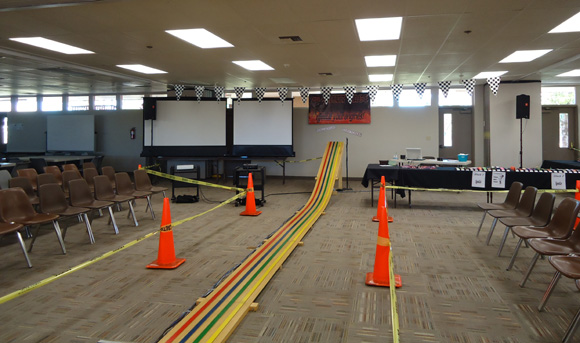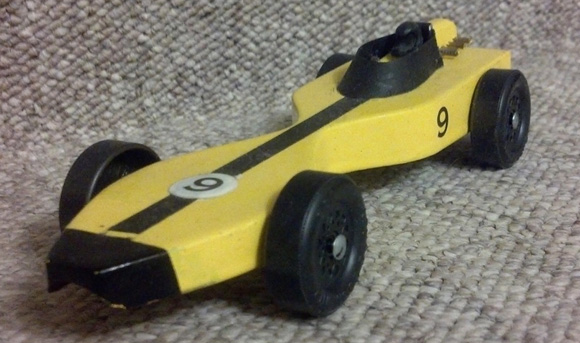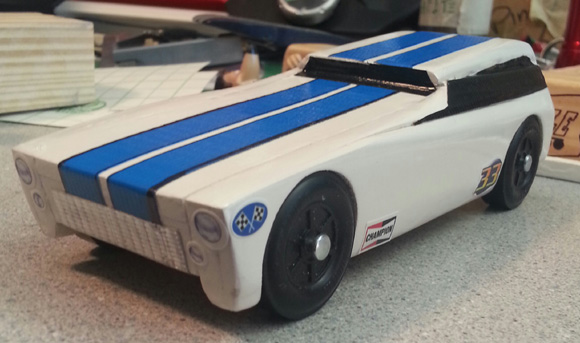– Feature Article – Handle Those Cars Carefully
– Pinewood Derby Car Showcase
– Q&A
Feature Article
Handle Those Cars Carefully
By Randy Davis
Sometimes I receive an e-mail that fills me with sympathy and some anger. Here is one of those e-mails from Scott Carpenter:
“This was the result of an accidental drop after a small child got hold of the car. We had another car get broken in the same race. Needless to say we will no longer race with a group that does not impose car handling guidelines.”
Photo 1 – Scott Carpenter’s Car
Ouch. Clearly, this car didn’t have much structure and needed to be carefully handled. But regardless, the real question is why was a small child allowed access to the car?
I believe that the race officials are responsible for safeguarding cars that have been checked-in. This safeguarding is not only to prevent damage to the cars, but also to prevent tampering with the cars by the car owner or by competitors. Therefore, after a car is checked-in, it may only be handled for the following reason:
- A race official may place a car onto the check-in/staging table.
- A race official may verify a car’s registration number if needed.
- A race official may place a car into storage (if the race is at a later date than the check-in).
- A car owner may stage the car (or a race official, depending on the race rules).
- A car owner may retrieve the car and put it back on to the staging table (or a race official, depending on the race rules).
- Under supervision of a race official, a car owner may repair a car (race rules should specify what repairs are allowed).
- No other person may touch a checked-in car.
If these guidelines are followed, then mishaps such as Scott Carpenter’s should never happen. However, there are many other factors that race officials need to address in order to minimize car damage and to prevent unauthorized access to cars. Let’s look at each stage of the race event and address car handling for each one.
Car Staging Equipment
First, race officials must provide a way for cars to be safely held on a staging table. Years ago, before any commercial solutions were available, we taped 1×2 inch boards lengthwise on the staging tables. The cars would then straddle the board, which kept them from rolling. Although a bit crude, this solution did secure the cars. I have seen photos of other simple solutions, as well as more elegant solutions, such as table-sized trays with slots for each car.
Check-In
Now that there is a way to immobilize checked-in cars, let’s consider area security. Pinewood derby cars are an attraction and people will naturally want to look and touch. So, race officials must establish a perimeter to keep unauthorized people away from the cars. I believe you do want people to be able to see the cars, but not allow them to touch the cars.
At our check-in, we use a line of tables as the perimeter. These tables are used as a work area for checking in the cars, and the staging tables are located behind the perimeter tables. Only race officials are allowed behind the perimeter tables.
Photo 2 – Our Check-in Area
(The corners of the perimeter tables are shown in the foreground.)
Another common way to limit access to the staging tables is with barrier tape (see “Race Day” for photos of barrier tape in use). However, with any method, you must have a person assigned to watch the staging tables to make sure unauthorized people do not gain access by going around, over, or under the perimeter barrier. It’s amazing the number of people that think that barriers do not apply to them.
Storage
If your race is held immediately after check-in, then you do not need to store the cars. But if your race is held on a day following the check-in, then a safe and secure storage method needs to be in place. We have a purpose built cabinet that was made to fit our parking lots. The cabinet is on wheels, has locked doors, and is rolled into a locked closet.
Photo 5 – Our Storage Cabinet
For even more security, we place a seal (actually a sticker name tag) across the doors. The name tag is signed by the club leader and me. If the cabinet is tampered with before it is officially opened on race night, then the tampering will be evident. This process may seem excessive to you, but if a parent ever asks how we ensure that no tampering occurs while the cars are stored, we are ready with a good answer.
Photo 6 – Security Seal
Race Day
On race day, the cars are secured on the staging tables, the perimeter is secure, and an official is watching the cars. All cables are secured with gaffer’s tape so that they are not a trip hazard. All cables that run the length of the track are on one side of the track, and all walking is done on the other side of the track.
Photo 7 – Use of Barrier Tape Around Race Area
Photo 8 – All Cabling on Left Side of Track, Traffic on Right Side
(Small table near track on right side is removed before the race)
Owner Staged Cars
If the race format has the car owners stage and retrieve their own cars, then all you have to do is supervise the staging table, starting line, and finish line to make sure the owners are only handling their cars. The rest is up to the owners.
Official Staged Cars
However, if your race format is for the race officials to stage and retrieve the cars, then some additional procedures must be in place.1 First two rules must be established:
- A race official never holds more than one car in each hand.
- A car is always held in the body area between the front and rear wheels. It is never held by the wheels or by the front or rear of the car.
These two rules greatly reduce the risk of dropping or damaging a car.
Now, it is just a simple matter of procedure. I will outline what we do; you can use this as a model, or modify it as needed.
Starting Line
We use three officials at the starting line. The first official pulls the cars for the next heat (two cars at a time), and places them on a parking lot near the starting gate. The other two officials place the cars (two per official) onto our four-lane track. One of the officials then triggers the starting gate.2 We have found that having a third official pull the cars for the next heat while the current heat is being run greatly speeds up the event.
I have seen some races where a carrier box is used to bring all of the cars to the starting gate at one time.3 This method can work well but it tends to be a little slower for staging heats. If you do use a carrier box, make sure the box immobilizes the cars so that they do not roll and do not bump into each other.
Finish line
We place two additional officials (usually responsible teens – this job involves a lot of squatting and can be tough on us older folks!) at the finish line to retrieve the cars. When the cars pass through the finish line, each official picks up two cars (one in each hand), brings the cars back to the staging table, and places them in their proper position. Admittedly, this job could be done by one official with a four-car carrier box.
Conclusion
Car safety and security should be foremost in the mind of race officials. People put blood, sweat, and tears (and money) into their cars and they have a right to expect that their cars will be treated with care. So, take the time to review your car handling procedures to make sure you are treating the cars with the care they deserve.
1 At our pinewood derby, we have five races: pre-school to kindergarten, first and second grade, third and fourth grade, fifth and sixth grade, and an outlaw race. The race officials stage and retrieve the cars for the first three races, and the car owners stage and retrieve the final two races.
2 The gate is triggered after first getting a “nod” from the person running the computer, and after verifying that the people retrieving the cars are in place and squatting down.
3 I am not a fan of carrier boxes as even a slight trip or misstep could result in cars flying out of the box. If one car is held in each hand, the person is more balanced and better able to recover from a misstep. But this is just my opinion.
Pinewood Derby Car Showcase
Shooting Star – Don Fish
This pinewood derby car was built by my son Nick for his Tiger derby. He loves Speed Racer, so we did our interpretation of Racer X’s Shooting Star. It won the den race, took third place in the pack and fourth place at district. The car has highly polished and notched axles, a raised front wheel, the center of gravity just in front of the rear axles, four wheel alignment with polishing, and of course Racer X and his rear engine V8!
Hot Rod Muscle Car – Jason Villarreal
A friend of mine wanted a fast, muscle looking car. So I cut out a design of what would be a hatchback. I started with a thin bottom plate and added the sides and top (so the car is hollow). The car took 1st for the age group, and 2nd overall. It also took 1st in the design category.
Q&A
Is there really much difference between the Max-V-Lube graphite and Krytox 100 oil?
With loose fitting axles (like the BSA axles, and the 4094 clone axles), graphite and Krytox 100 have similar performance. As you work in the graphite, it builds a coating on the bore of the wheel, reducing the diameter. This tightens up the slop, resulting in better speed. Just make sure to thoroughly work in the graphite, adding, spinning, adding spinning, etc.
Krytox 100 works better than graphite when using precision fitting axles, such as our new stainless steel axles and super speed axles. It also works best for all of the outlaw wheels/axles. In addition, Krytox 100 works well for Awana wheels and axles.
Want Answers?
Do you have a pinewood derby-related question? If so, e-mail us your question.We answer all questions by e-mail, but not every question will appear in the Q&A section of the newsletter.
Back Issues
Are you a new subscriber, or have you missed some of the previous newsletters? Don’t miss out; all of the issues for Volume 5 through Volume 17 are posted on our web site.
Newsletter Contributions
We welcome your contributions. If you would like to contribute an article, a web site review, a speed tip, or a pinewood derby memory, please e-mail us.
Subscription Information
The Pinewood Derby Times is a free e-newsletter focused on pinewood derby racing. It is published biweekly from October through March.
If you haven’t already done so, please forward this issue to your pinewood derby friends. But please don’t subscribe your friends. Let them decide for themselves. Thanks.
If this newsletter was forwarded to you, why not subscribe to receive this newsletter. There is no cost, and your e-mail address is safe, as we never sell or share our distribution list.
To subscribe, send a blank e-mail to
[email protected]
You will receive a confirmation e-mail. Reply to the confirmation e-mail and you will start receiving the Pinewood Derby Times with the next issue.
Randy Davis, Editor, Pinewood Derby Times
E-Mail: [email protected]
(C)2018, Maximum Velocity, Inc. All rights reserved. Please do not reprint or place this newsletter on your web site without explicit permission. However, if you like this newsletter we grant permission, and encourage you to e-mail it to a friend.
Maximum Velocity disclaims any personal loss or liability caused by utilization of any information presented in this newsletter.
The Pinewood Derby Times is not specific to, and is not affiliated with the Boy Scouts of America, YMCA, Awana, or any other organization.
(R)Maximum Velocity is a registered trademark of Maximum Velocity, Inc.
(R)Pinewood Derby is a registered trademarks of the Boys Scouts of America.
(R)Awana is a registered trademark of Awana Clubs International.
All other names are trademarks of their respective owners.

